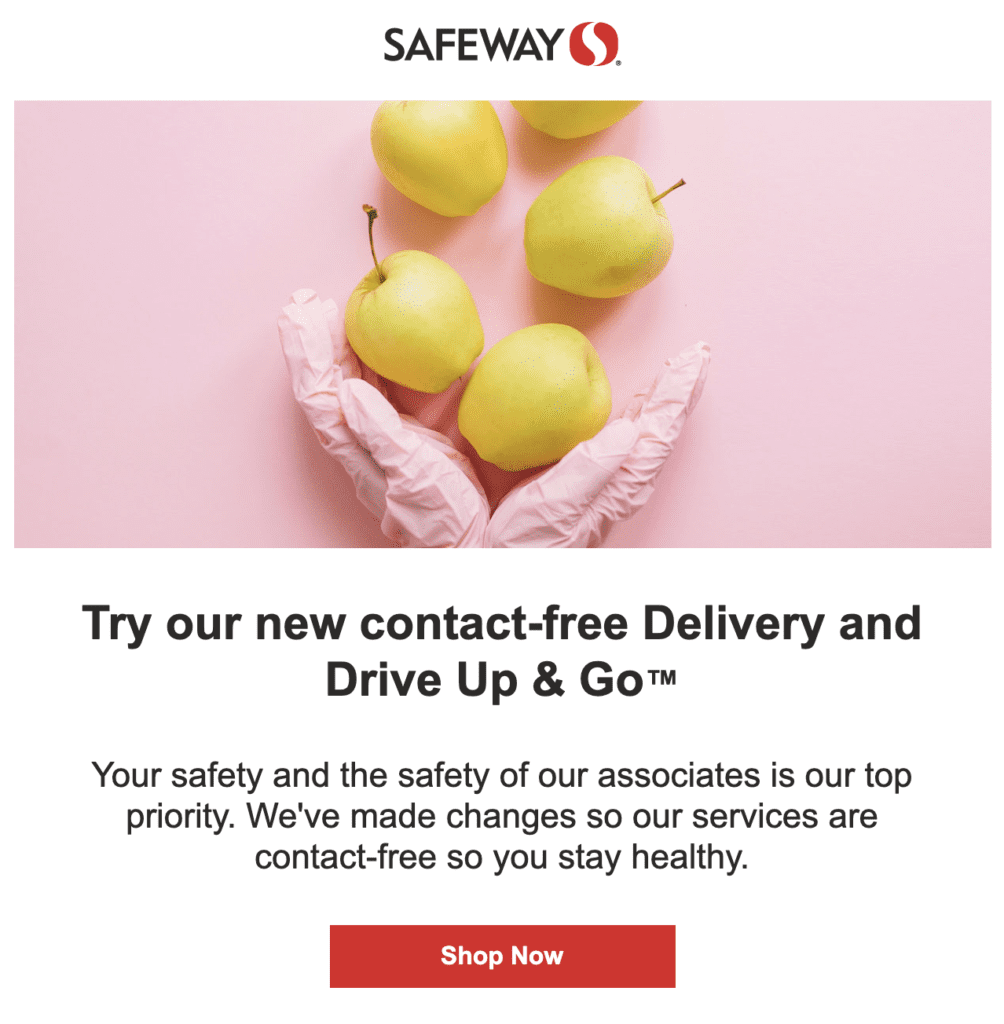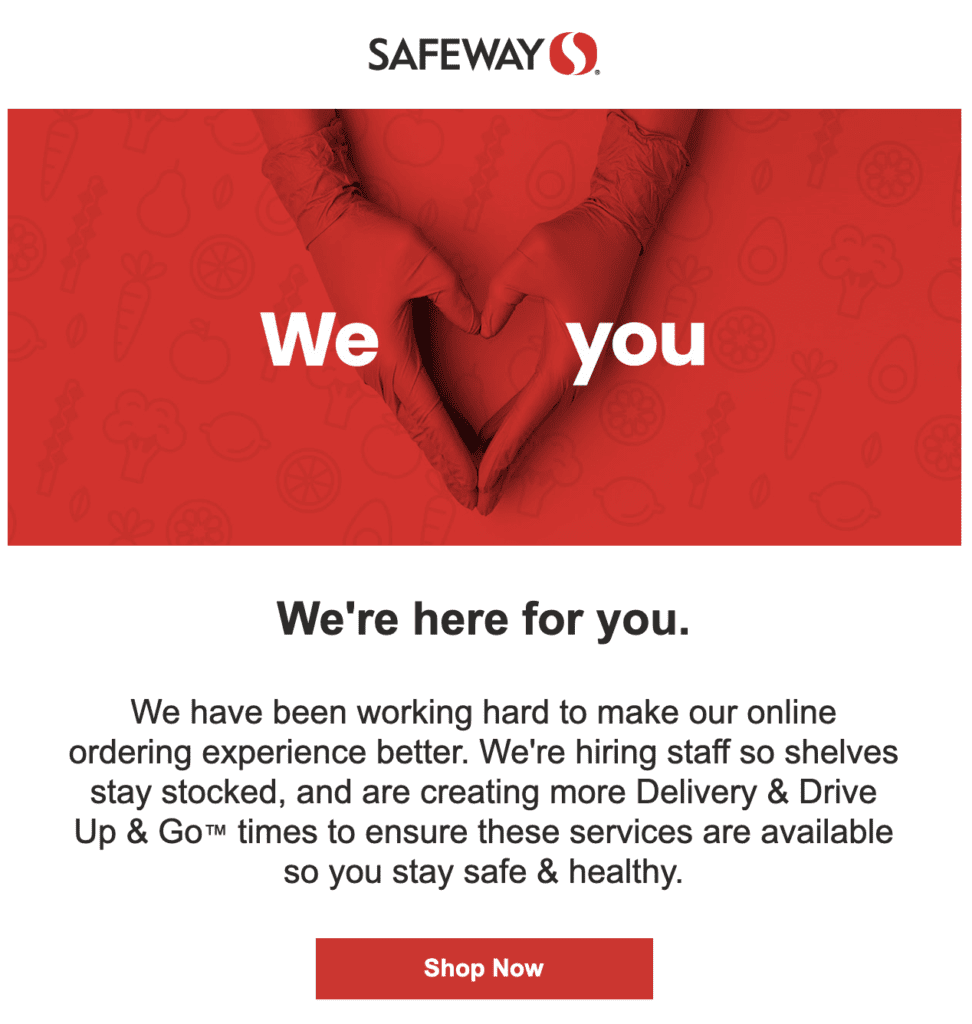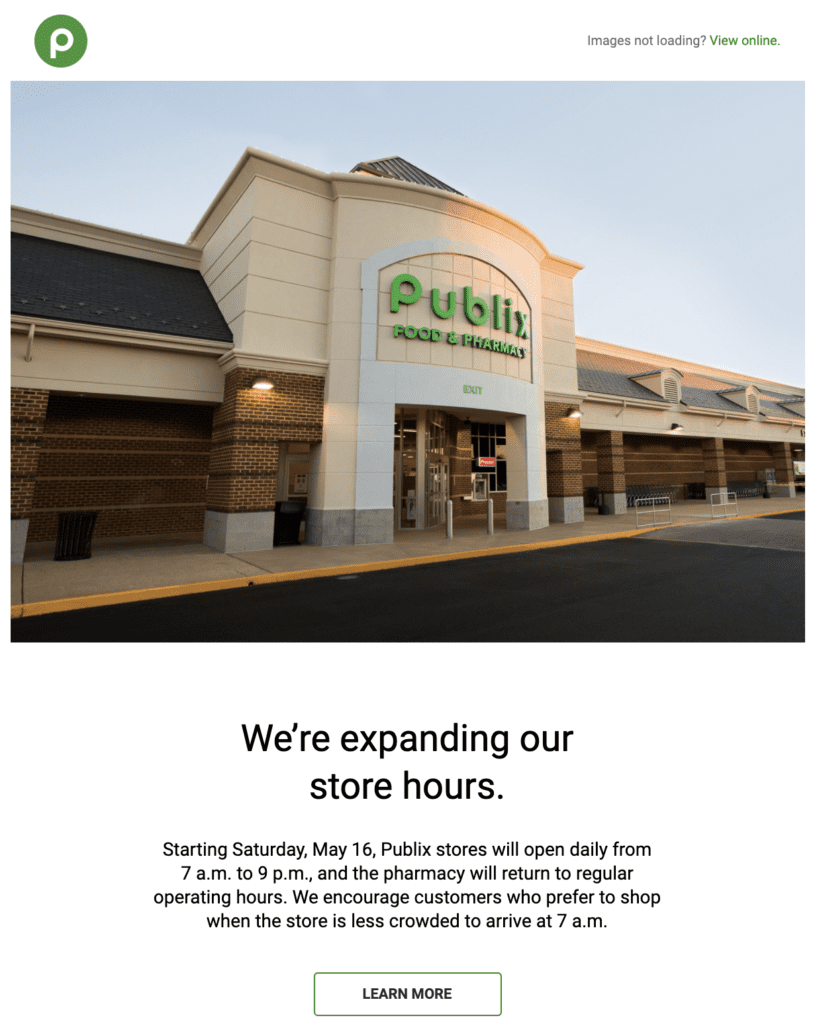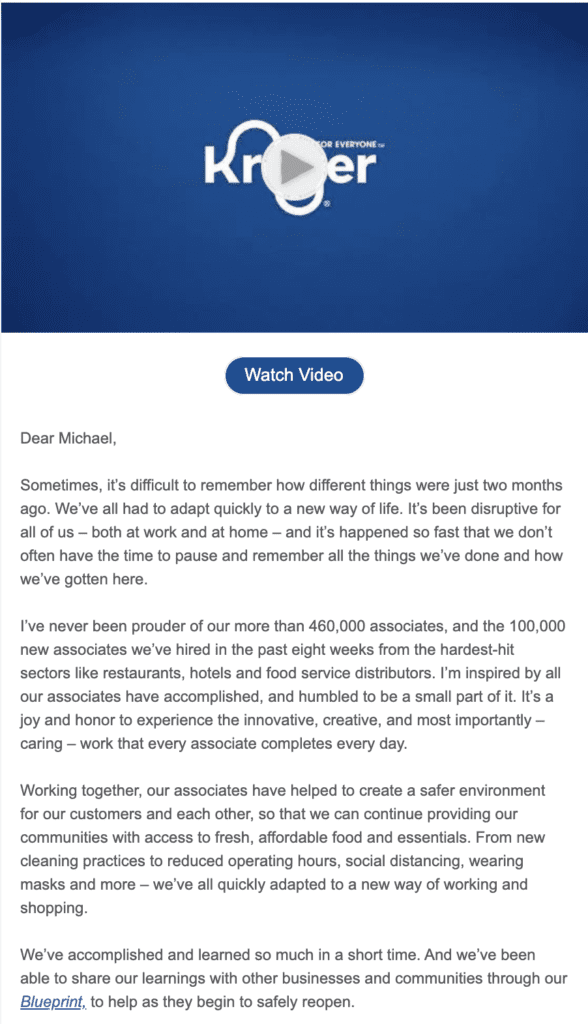Grocery shopping during COVID-19 has adopted a sort of choreography. Each move working in tandem for the safety of ourselves and those around us. Write a list, grab your mask, keep six feet apart, stick to the list, no dilly-dallying. Even online shopping has undergone changes with new procedures in place for contact-less deliveries to keep customers and drivers safe.
It’s a lot to remember when fulfilling a task that has for so long been absolutely vital, but simultaneously mundane in its repetition.
Needless to say, with these new concerns, grocery shopping under COVID-19 restrictions has altered the grocery industry in potentially permanent ways.
We recently took a look at how marketers at grocery brands like Safeway, Kroger, and Publix have adapted to keep customers at ease while communicating how their organizations are working to simplify the shopping experience for everyone.
Whether or not you’re working in this industry, all marketers can learn from these insights on how to pivot their own companies’ messaging and put empathy at the forefront.
The Grocery Industry as It Stands Now
First and foremost, consumer behavior has changed. Prior to the coronavirus outbreak, shoppers averaged 2.7 trips weekly to 4.1 different stores. After the outbreak, the frequency jumped to 3.6 trips per week, but 40% of shoppers limited the number of stores they visited.
The increased time that more members of households are spending at home has also altered the makeup of a typical week of groceries. Forced restaurant closures have significantly impacted how much the average consumer eats out, meaning more meals are being made at home.
Consequently, grocery budgets jumped 33% before leveling out, albeit still at a higher rate than before COVID-19.
The change, however, that is most likely to stick is the surge of online grocery shopping. While studies had shown online shopping to be increasing in the food retail industry, coronavirus restrictions have expedited this growth substantially.
In March 2020, food and beverage took over as the second-most likely product for consumers to buy online. Online grocery shopping as a percentage of all grocery spending has risen to 27.9% in March and April of 2020—up from 10.5% in 2019 and 14.5% in February 2020.
It’s no guarantee that shoppers will continue to utilize online options for their grocery needs when restrictions are lifted, but this experience could lead to more consumers opting for the convenience of delivery or curbside pickup moving forward.
Marketing Grocery Shopping Under COVID-19
So, where does this all leave the consumer-brand relationship amidst an unprecedented set of operating procedures? And how have grocery chains altered their marketing strategies to fit changing demands?
For one, cleanliness now reigns as the top priority for consumers considering a grocery store. As laid out above, there are a host of considerations shoppers take before venturing out of their homes and into a busy environment.
Grocery brands have had to adapt their marketing messaging to emphasize not only how seriously they are taking this situation, but also how they plan on simplifying this complex process for everyone.
In late April and early May, American supermarket chains Kroger and Safeway made sure to alert their customers about their new processes and offerings.
As seen below, Kroger sent a list of tips that laid out the best ways to shop while staying safe, which included information about special instructions, payment options and free shipping thresholds.


In such a new shopping environment, it’s important to simply lay out the new processes for customers.
Safeway, on the other hand, maintained its brand styling by keeping this email below clean and concise, but still found a way to introduce its new contact-free delivery options.


A concise message can be just as effective to keep customers updated.
As you might expect with an essential business that is experiencing drastic increases in demand, supermarkets have seen more shelves out of stock. To fix this, grocery brands are seeking help.
This year has seen a large growth in job postings at grocery stores. Safeway let customers know they recognize its stocking challenges and explained what the company is doing to make sure that customers can find what they need without issue.


Safeway wants customers to feel taken care of for all considerations.
For much of the time that the world has been sheltering-in-place, grocery brands have focused their marketing strategies on their delivery options, hoping to stimulate online purchases. That said, there have still been efforts to get in-store shoppers to return.
Expanding store hours has been a common tactic taken by many brands to help senior citizens shop more safely. Publix, one of the largest supermarket chains in the American southeast, sent a dedicated email to this strategy to strengthen its message.


Some offerings warrant their own message to ensure your whole audience is paying attention.
With restrictions changing on a semi-weekly basis, it’s important for brands to keep their messaging targeted and direct. This is a crucial time to ensure all emails and other messages contain a single call-to-action (CTA) that explains procedures or restrictions in a clear manner.
It’s also important to stay true to your business model. While delivery has grown in popularity, the in-store experience is still crucial to the grocery industry’s survival. When creating marketing campaigns, grocery brands have to weigh which aspects of their offerings to promote and when.
Leveraging behavioral data to identify users that more inclined one way or the other (in-store vs. delivery) makes segmentation and personalization that much easier.
Safety and Solidarity
Like many businesses this year, grocery brands have fully adopted empathy into their marketing strategies. The customer is no longer a shopper; they are human.
Kroger provided a great example during the height of the initial outbreak with both a written and video message from its CEO.


A direct message from an executive spokesperson can go a long way in humanizing a brand.
Keeping the customer safe, happy, healthy, and comfortable. That’s the top priority expressed by grocery brands.
However, recent acts of racist violence have put a spotlight on redefining “safe” to go beyond health standards, and supermarket chains have addressed how they’re stepping up to support the Black community.
Publix heard the call for anti-racist action and sent a simple message regarding the Black Lives Matter movement, which included “a $1 million contribution to National Urban League affiliates across the Southeast.”


Simple. To the point. No frills. Get your message across while giving the reader the option to learn more.
Between civil rights and the coronavirus redefining our daily lives, brands have to take public sentiment into consideration when crafting marketing campaigns.
Marketers looking to address these topics must understand their customer base at a deeper level to identify who needs to know what and why.
The (Fireworks) Show Must Go On?
Although supermarkets have addressed recent events with empathy, no business is in the position to pause or cancel regular marketing programming. The summer holidays, in particular, are hugely important for grocery stores with the 4th of July alone accounting for over $6.5 billion in sales.
Kroger promoted its barbecue offerings for Memorial Day, Father’s Day and Independence Day, while occasionally offering subtle nods to the shelter-in-place restrictions in their messaging.


Just because the world is in utter chaos, doesn’t mean consumers aren’t finding time to relax.
When it comes to promotions, it’s important for marketers to not overdo it. Burnout and overload are real, especially for consumers, who prefer to be in control of the frequency with which they receive marketing messages.
Evaluate and adjust your preference center to let each customer choose when and how they interact with your brand. In doing so, brands can gain trust and strengthen relationships as subscribers will only be receiving messages that work best for their schedule and engagement preferences.
Marketing Grocery Shopping With Empathy
We’ve all read the news: Coronavirus cases are still rising. We may want to talk about what grocery shopping will look like after the pandemic, but the reality is we’re here for the long haul and we’re in this together.
Grocery marketers have the tall task of walking customers through new shopping procedures—conveying a sense of calm and comfort all while promoting their products. We’ve seen time and time again that brand transparency and an empathetic tone to marketing strengthens customer loyalty.
The grocery store is a longstanding symbol of community and togetherness. Now is as good a time as any for grocery brands to foster that sense of community with personalized messaging and a few virtual air hugs.
Looking for more information about how best to connect with your customer base from a distance? Check out our Resources page. We’d recommend starting with our guides on empathy and marketing during a crisis.





























